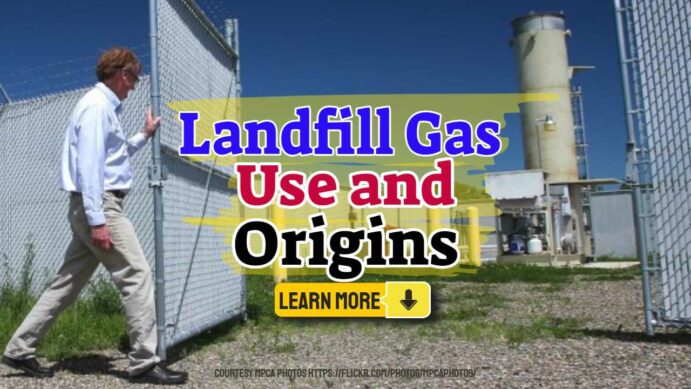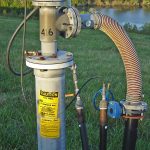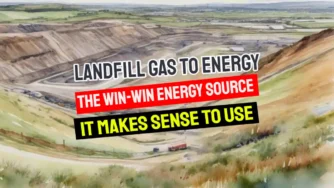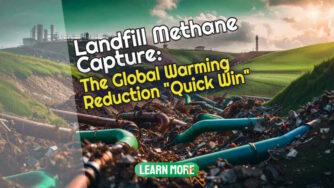Landfill gas use is the collection and treatment of methane or other gaseous substances from the decomposition of waste in a landfill to create power, heat, and energy.
In addition to fossil fuels and farming, municipal solid waste (MSW) landfill gas was third in the world as the contributor to methane emissions as a greenhouse gas.
At the COP26 Climate Change conference held in Glasgow in November 2021, a group of nations, including the US, the UK, and the EU, pledged to capture landfill gas from all current landfills.
Methane is a potent greenhouse gas that traps heat in the atmosphere. It was previously thought to be 28 to 36 times more effective than CO2 over a 100-year period, until very recently. However, the ratio has now been raised to over 80 times more damaging than CO2.
Methane and carbon dioxide are the main constituents, and the emission of methane is prevented, at its most simple, by flaring the collected landfill gas.
The landfill gas industry, which provides the equipment and the labour force to install landfill gas extraction systems is expected to grow rapidly in the next few years as a result of rising demand for their products and services.
The aim globally is to halve or better the current rate of greenhouse gas emissions from the world's municipal solid waste landfills.
Basic information about landfill gas
Landfill gas (LFG) is a mixture of various gases produced by microorganisms within a landfill as they break down organic waste, such as food waste and paper trash. Landfill gas is made up of between 40% to 60% methane, with the rest being largely carbon dioxide.
The remaining 1% is made up of trace levels of other volatile organic compounds (VOCs) (non-methane organic compounds). A wide range of substances, mostly simple hydrocarbons, make up these trace gases.
In the US the Agency for Toxic Substances and Disease Registry of the U.S. Environmental Protection Agency, US Department of Energy Information Administration provides guidance on exposure limits for these substances.
LFG is a renewable energy resource that can be harvested, processed, and utilized.
Methane emissions from landfills
In the United States, the Clean Air Act mandates the installation and operation of a landfill gas collection and control system for municipal solid waste landfills of a specific size. Some landfills minimise landfill gas emissions by catching and burning the gas, which is known as flaring.
CO2 is produced when methane in landfill gas is burned, however, CO2 is not as potent a greenhouse gas as methane. Many landfills collect and process landfill gas to remove carbon dioxide (CO2), water vapour, and hydrogen sulphide (H2S – spelt hydrogen sulfide in the US).
To assess the health impacts of landfill gas exposure, studies have been done in communities near landfill waste and waste lagoons. These trials lasted many months and revealed health issues that correlated with increasing hydrogen sulphide levels and landfill smells.
Eye, throat, and lung discomfort, nausea, headache, nasal obstruction, sleeping difficulties, weight loss, chest pain, and asthma exacerbations were among the health issues noted. Despite the presence of other substances in the air, many of these effects remain consistent with the known effects of H2S exposure.
When LFG is collected and either flared, combusted to power a generator, or upgraded to make a more valuable fuel known as biomethane the gases such as H2S and other odour-forming compounds in the LFG are either removed or destroyed in the flame. The gas produced contains toxic substances, such as NOx emissions are also reduced by landfill gas use.
LFG collection systems
Installing wells in the trash heap that are vertically and/or horizontally positioned is a common method of obtaining landfill gas collection. Vertical wells should be separated approximately 50–200 feet apart in the centre, according to design heuristics, while horizontal wells should be spaced about 50–200 feet apart in the centre, according to commonly adopted design wisdom. Horizontal wells are not recommended due to clogging.
To avoid gas migration issues, landfills should always install gas collection systems.

Landfill Gas Energy Production
The Landfill Methane Outreach Program (LMOP) of the United States government provides basic information regarding landfill methane use in the United States. According to its most recent report, there are 548 operating LFG energy projects in the United States as of September 2021, and 483 landfills that are strong prospects for future projects.
Landfill gas production generally starts when the methane-producing bacteria begin to multiply between 3 months and 5 years after any part of a landfill is filled with waste. The maximum output from any part of the landfill will vary generally between 5 and 15 years.
If the temperature or moisture content rises, the gas output will rise as well. Barometric pressure has also been shown to affect LFG output. When the atmospheric pressure drops after a period of high pressure, an effect rather like the fizzing that occurs on opening a bottle of lemonade takes place and often results in a higher gas flow for a period of a few days.
A landfill can emit gases for more than 50 years, even though production of these gases typically peaks in five to seven years.
Collecting and treating landfill gas
Methane and CO2 are well-known greenhouse gases that contribute significantly to global warming when anaerobic bacteria decompose organic waste to produce biogas.
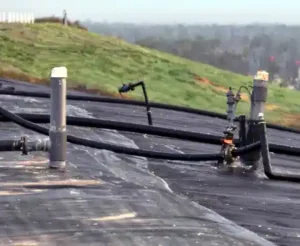
There are advantages to collecting and treating landfill gas by flaring, its use in a generator engine, or upgrading it to become a natural gas replacement beyond climate change mitigation. Using LFG reduces smells and other risks connected with LFG emissions, as well as methane migration into the atmosphere, which contributes to local pollution and global climate change.
Collecting the gas (LFG) involves drilling perforated pipes into the waste and then applying suction to pull the landfill gas out. Leachate may be present in the landfill, and this must be drained in a manner that prevents it from getting into the gas wells.
Renewables vs Natural gas
Landfill gas is classified as a renewable gas because the majority is produced from recently grown organic matter. In contrast, natural gas is extracted from the ground from deposits that were laid down over geological time amounting to millions of years. There is no way in which those geological deposits can be renewed in a significantly shorter period. For this reason, natural gas is non-renewable.
The breakdown of organic waste in anaerobic digestion facilities also produces landfill gas, which is also biogas. Renewable energy sources such as landfills and the commercial development of the anaerobic digestion process are a big opportunity to provide a transitional renewable energy source to aid global decarbonisation.
Direct Use of Medium-Btu Gas
Microorganisms acting on organic wastes, such as landfills, produce a medium Btu gas comprising methane and carbon dioxide. Firing pottery and glass-blowing kilns, generating and heating greenhouses, and evaporating waste paint are all examples of innovative direct applications of medium-Btu gas from landfills.
Flaring
The burning of natural gas in conjunction with:
- oil extraction, or
- when done on landfill sites,
- is known as gas flaring.
The practice dates back over 160 years, and it occurs in the oil industry owing to a variety of factors, including market and economic limits, a lack of sufficient regulation, and political wilfulness.
The first landfills to start to produce LFG were discovered to be “gassing” in the late 1970s. As noted already, due to concerns about the rate of climate change, and the ability of a reduced methane gas emission rate to reduce global warming, the world's governments will now be legislating to require the collection and flaring or use of all landfill gas.
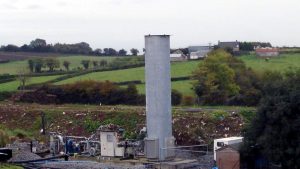
Electricity generation
Financing Landfill Gas Projects in Developing Countries Landfill gas management can help mitigate greenhouse gas emissions and contribute to the overall safe operation of a landfill, simultaneously generating revenue.
Installing a reciprocating landfill gas engine is technically the easiest and lowest capital cost option as long as there is a user for the power nearby or a suitable electrical power line nearby through which to export the electricity.
Microturbines are primarily employed for lower LFG volumes and specialist applications, while gas turbines are frequently used in bigger LFG energy projects.
In the United States, over 70% of currently active LFG energy plants generate electricity. To produce energy for onsite consumption and/or sale to the grid, several technologies can be utilised, including reciprocating internal combustion engines, turbines, microturbines, and fuel cells.
Because of its low cost, high efficiency, and size range that complements the gas production output of various landfills, the reciprocating engine is the most often utilised conversion technology for LFG electrical applications.
Landfill gas treatment
Since 2017 rising awareness of the benefits of using methane as a heavy goods vehicle fuel to replace the high current cost and polluting effects of diesel landfill gas treatment has moved on to the purification of the raw LFG to a natural gas replacement known as renewable natural gas (rNG) or compressed biomethane. The other landfill gases are removed from the biogas to make pure methane gas, and the separated carbon dioxide can also have a value when sold.
LFG is upgraded to renewable natural gas (RNG), a high-Btu gas, through treatment processes by increasing its methane content and, at the same time reducing its CO2, nitrogen, and oxygen contents. RNG can be utilised as pipeline-quality gas, compressed natural gas (CNG), or liquefied natural gas in place of fossil natural gas (LNG).
FAQ: Landfill Gas Use and Origins
1. What is landfill gas use?
Landfill gas use refers to the collection and treatment of methane or other gases that arise from the decomposition of waste in a landfill. This collected gas can be used to generate power, heat, and energy.
2. Why is landfill gas a concern?
Methane, a significant component of landfill gas, is a potent greenhouse gas. It traps heat in the atmosphere and is now considered over 80 times more damaging than CO2 over a 100-year period.
3. What is the composition of landfill gas?
- Methane (40%-60%)
- Carbon Dioxide
- 1% of trace levels of volatile organic compounds (VOCs)
4. What measures are taken to control methane emissions from landfills?
In the US, the Clean Air Act mandates the installation of a landfill gas collection and control system for specific municipal solid waste landfills. This gas can be caught and burned (flared) to minimize emissions.
5. What are the health impacts of landfill gas exposure?
Exposure to landfill gas, especially hydrogen sulphide, can lead to symptoms like eye, throat, and lung discomfort, nausea, headaches, nasal obstruction, sleeping issues, chest pain, and asthma exacerbations.
6. How is landfill gas collected?
Landfill gas is typically collected using perforated pipes drilled into the waste. Suction is then applied to extract the gas. It is essential to drain any leachate to prevent it from entering the gas wells.
7. How does landfill gas production work?
Gas production generally starts between 3 months and 5 years after a landfill is filled with waste, peaking between 5 and 15 years. A landfill can continue emitting gases for over 50 years.
8. How does landfill gas compare to natural gas?
Landfill gas is renewable because it's produced from recently grown organic matter, whereas natural gas is extracted from geological deposits formed over millions of years, making it non-renewable.
9. What is the direct use of medium-Btu gas?
Pottery firing, glass-blowing kilns, and the evaporation of waste paint are just a few direct uses for the medium Btu gas that microorganisms acting on organic wastes produce.
10. What is flaring?
Flaring refers to the burning of natural gas associated with oil extraction or at landfill sites.
11. How can landfill gas be used for electricity generation?
Landfill gas can be converted into energy for onsite consumption or exported to the grid. Technologies include reciprocating internal combustion engines, turbines, microturbines, and fuel cells. Reciprocating engines are the most common conversion technology due to their efficiency and cost-effectiveness.
12. What is renewable natural gas (RNG)?
RNG is upgraded landfill gas, treated to increase its methane content while reducing its CO2, nitrogen, and oxygen contents. It can replace fossil natural gas and be used as pipeline-quality gas, compressed natural gas (CNG), or liquefied natural gas (LNG).
13. How significant is the landfill gas industry?
With increasing emphasis on capturing landfill gas due to its environmental implications, the landfill gas industry is anticipated to experience rapid growth in the upcoming years.
I hope this FAQ section provides readers with quick answers to some of the most common questions regarding landfill gas use and origins.
[First published: Dec 29, 2021]. [Post updated by adding FAQs Section August 2023.]
Best Practices in Odour Control Using Landfill Gas Extraction Systems
Landfill gas extraction systems effectively control odour by capturing and treating gases from decomposing waste. Proper system design, strategic well placement, and regular maintenance are crucial for minimizing fugitive emissions and odour complaints, with reductions of up to 85% achievable when these best practices are followed…
US Landfill Gas Resources: A Booming Green Energy Sector
Untapped U.S. Landfill Gas Resources are an Opportunity for Green Investment The American landfill gas (LFG) sector has seen a big change in recent years. It's now a key player in the country's biogas world. Even though it's only 23% of over 2,500 biogas systems now installed nationwide, it captures 72% of all biogas by […]
Flare Systems for Landfill Gas: Improving Environmental Compliance
Landfill flare systems convert harmful methane into less potent carbon dioxide, reducing greenhouse impact. Enclosed flares offer up to 99.9% efficiency. Compliance with EPA regulations and maintenance are critical for optimal performance, ensuring these systems help us meet environmental goals and protect communities from emissions…
Landfill Gas Power Plants
Landfill Gas Power Plants should be installed at all landfills, where the landfill gas (LFG) extraction rate is large enough to sustain a steady flow for long periods (multiple years). A typical Landfill Gas Power Plant for most landfill sites is an internal combustion engine, or possibly a gas turbine. The typical landfill gas power plant is used […]

